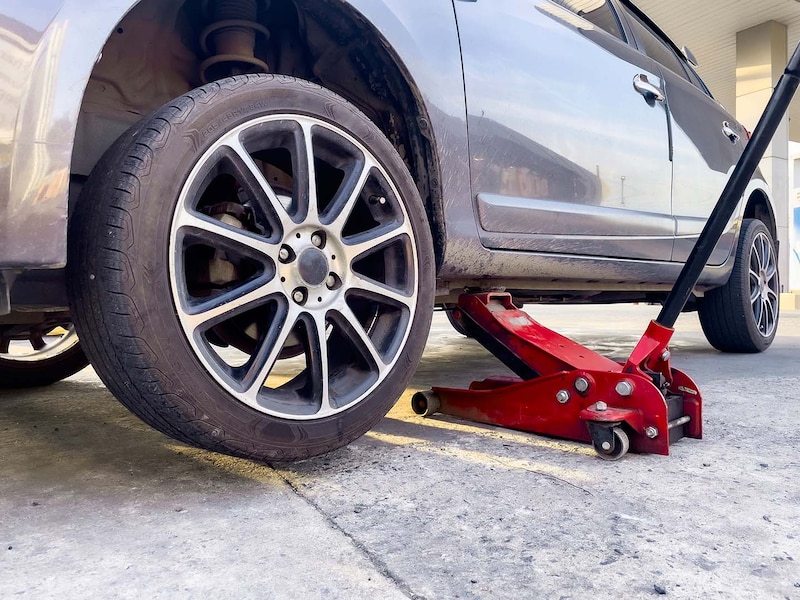How to jack up your car

Quick insights
- A car jack is a device used to lift a portion of your vehicle off the ground, making it an essential tool for tire changes and certain types of maintenance.
- Using a car jack involves a series of steps to help make sure the vehicle is lifted safely and securely.
- Following car jack safety tips can help prevent accidents during the lifting process and damage to the vehicle.
As car owners, we often focus on the road ahead. But what about the road beneath? Over 40% of U.S. drivers get a flat tire each year, and if you don't know how to use a car jack you might be left flat footed. Let's elevate our knowledge on car jacks, a tool that's just as important as your spare tire.
What is a car jack?
A car jack is a mechanical device used by vehicle owners and mechanics to lift cars off the ground. This is typically done for tire changes or when certain maintenance tasks need to be performed under the vehicle, such as changing oil or inspecting brakes.
A car jack works by applying force to a certain point in the vehicle, allowing one side or corner of the car to be lifted off the ground. It’s important to position the jack under a secure point of the vehicle, like the frame rails or reinforced jack points. There are several types of car jacks including scissor jacks, hydraulic jacks and bottle jacks. The type of jack you use will depend on the type of work you need to do and the weight of your vehicle. For example, you my need to use a car jack if you get a flat tire.
How do you use a car jack?
Using a car jack involves a series of steps to ensure the vehicle is lifted safely and securely.
- Park on a flat, stable surface: This is the first and one of the most important steps. Parking on a flat, stable surface helps keep the car stable and avoid rolling or shifting while it's being jacked up. Avoid surfaces like grass or gravel that can potentially shift under the weight of the vehicle.
- Engage the parking brake: This provides an additional safeguard against the car rolling. The parking brake, also known as the emergency brake, locks the vehicle's wheels and prevents them from moving. This is especially important when the car is being lifted off the ground.
- Locate the jack points: These are the points on the car that are designed to withstand the force of the jack. They are typically located under the vehicle's frame alongside the front and rear wheels. Refer to your vehicle's owner's manual to find these points. Using the correct jack points can prevent damage to your vehicle and allow for a stable lift.
- Position the jack: Place the jack under the jack point and make sure it’s centered and stable. The jack should be positioned so that it makes secure contact with the jack point. Incorrect positioning can lead to the jack slipping and potentially causing damage or injury.
- Raise the jack: Use the handle or lever to raise the jack until it contacts the jack point. Continue raising the jack until the car is lifted to the desired height. Raise the vehicle only as high as necessary to prevent instability.
- Use jack stands: If you need to work under the vehicle, such as for an oil change, you should always use additional support such as jack stands.
- Check the stability: Before starting your work, gently push the car to make sure it's stable on the jack. This is a simple but important safety step. If the car feels unstable or shakes on the jack, it may not be safe to start working.
- Lower the jack: When you're finished with your work, slowly lower the jack until the car is back on the ground. Then remove the jack from under the car. Lowering the jack slowly ensures that the car is safely and gently returned to the ground, preventing any sudden movements or impacts.
Car jack safety tips
Using a car jack safely can help prevent accidents and damage to the vehicle. Below are some tips to consider:
- Use the right type of jack: Make sure the jack you're using is suitable for your vehicle's weight.
- Regularly inspect your jack: Check your jack for any signs of damage or wear before using it.
- Don't exceed the jack's weight limit: Every jack has a maximum weight limit. Never use a jack to lift a vehicle that exceeds this limit.
The bottom line
A car jack is an important tool for any vehicle owner, allowing you to lift your car safely and effectively for tire changes and certain types of maintenance. Knowing how to use a car jack properly and adhering to safety guidelines can help prevent accidents and damage to your vehicle. Whether you're a seasoned driver or a car owner, understanding the workings of a car jack is a skill that's sure to come in handy on the road.



